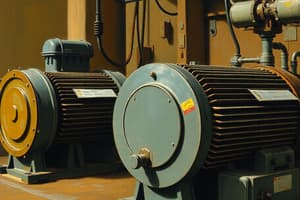Podcast
Questions and Answers
What is the main function of a transformer?
What is the main function of a transformer?
- To generate electrical energy from a magnetic flux
- To amplify electrical signals
- To transfer electrical energy from one circuit to another (correct)
- To convert electrical energy into mechanical energy
What effect does a varying current in any coil of the transformer produce?
What effect does a varying current in any coil of the transformer produce?
- A decrease in magnetic flux
- An induced electromotive force (EMF)
- A constant magnetic flux
- A varying magnetic flux (correct)
What does Faraday's law of induction describe?
What does Faraday's law of induction describe?
- The behavior of conductive materials in a magnetic field
- The induced voltage effect in any coil due to changing magnetic flux (correct)
- The effect of voltage on a transformer's core
- The resistance of a coil in a transformer
What is the significance of transformers in electric power applications?
What is the significance of transformers in electric power applications?
What is the purpose of using step-up or step-down transformers?
What is the purpose of using step-up or step-down transformers?
What type of magnetic materials does a permanent magnet pull on?
What type of magnetic materials does a permanent magnet pull on?
How does a moving charge in a magnetic field experience force in relation to its own velocity and the magnetic field?
How does a moving charge in a magnetic field experience force in relation to its own velocity and the magnetic field?
What unit is used to measure magnetic flux density in the International System of Units?
What unit is used to measure magnetic flux density in the International System of Units?
In electromagnetics, what term is used for two distinct but closely related vector fields denoted by the symbols B and H?
In electromagnetics, what term is used for two distinct but closely related vector fields denoted by the symbols B and H?
What are the three other magnetic effects that a nonuniform magnetic field exerts forces on 'nonmagnetic' materials?
What are the three other magnetic effects that a nonuniform magnetic field exerts forces on 'nonmagnetic' materials?
Flashcards are hidden until you start studying
Study Notes
Transformers and Electromagnetics
- The main function of a transformer is to transfer electrical energy from one circuit to another through electromagnetic induction.
Electromagnetic Induction
- A varying current in any coil of the transformer produces a changing magnetic flux, which in turn induces an electromotive force (EMF) in the coil.
Faraday's Law of Induction
- Faraday's law of induction describes how a changing magnetic flux induces an EMF in a closed loop of wire.
Significance of Transformers
- Transformers play a crucial role in electric power applications by enabling the efficient transmission and distribution of electrical energy over long distances with minimal loss of energy.
Step-up and Step-down Transformers
- The purpose of using step-up or step-down transformers is to increase or decrease the voltage of an alternating current (AC) signal, respectively, to match the requirements of the load or transmission line.
Magnetic Materials
- A permanent magnet pulls on ferromagnetic materials, such as iron, nickel, and cobalt.
Force on a Moving Charge
- A moving charge in a magnetic field experiences a force perpendicular to its velocity and the magnetic field, described by the Lorentz force equation.
Magnetic Flux Density
- Magnetic flux density is measured in teslas (T) in the International System of Units (SI).
Magnetic Field Vector Fields
- In electromagnetics, the terms "magnetic induction" and "magnetic field strength" are used to describe the two distinct but closely related vector fields denoted by the symbols B and H, respectively.
Nonuniform Magnetic Field Effects
- A nonuniform magnetic field exerts forces on "nonmagnetic" materials, resulting in three additional magnetic effects: the magnetocaloric effect, the magnetostatic effect, and the magnetostrictive effect.
Studying That Suits You
Use AI to generate personalized quizzes and flashcards to suit your learning preferences.




